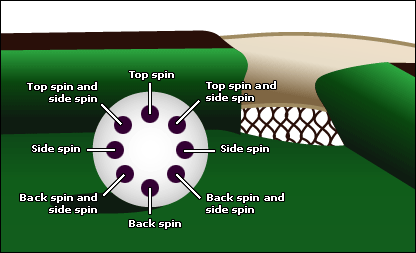
Learning how to apply spin to the cue ball can completely change your game — whether you're playing snooker, billiards, or pool. With consistent practice, you'll gain more control over shot direction, cue ball positioning, and recovery from tricky situations.
So why use spin? Spin helps control where the cue ball goes after contact with the object ball. It can also help you escape snookered positions by curving the cue ball off cushions. Spin opens up new angles, options, and strategies.
Imagine the cue ball as a clock:
Hitting between those points creates blended effects like top-side or bottom-side. Your cue ball response depends on both where and how hard you strike it.
Top spin is applied by striking the cue ball above its centre. The higher the strike, the more follow is created. The cue ball will continue forward after contact with the object ball. This helps maintain momentum and improves position for the next shot.
Tips: When cueing from a cushion, use a shorter stroke and avoid side spin. Finish your stroke fully with a smooth, controlled delivery. Avoid sudden power — keep the tempo even and let the top spin take effect naturally.
Bottom spin is achieved by striking the cue ball below centre. This pulls the cue ball back after hitting the object ball. With the right amount of bottom, you can create a stun shot — where the cue ball stops dead on contact. More backspin will cause the cue ball to reverse direction completely.
Bottom spin is key for precise position play, particularly when you want to come back for the next ball or control the pace of your break.
Side spin is used to affect the cue ball’s angle off the cushion or object ball. In some countries, this is also called “English.” You apply it by striking the cue ball to the left or right of the centre spot.
Use only 1–2 tips of side spin from centre. Stay at cue ball centre height or just slightly above for better accuracy. Applying side spin changes the cue ball’s reaction and can widen or narrow your angle — but overusing it can cause you to miss pots.
Make sure to align your cue before getting down, and always apply side with a plan. Don’t guess. Practice how your cue reacts to side spin — each cue performs differently.
You can mix top/bottom with side spin to create even more shot variety. For example:
These shots are harder to master but add a lot of control to your game once you learn how your cue reacts.
Spin changes with power. The same strike point will produce different spin based on how firmly you hit the ball. That’s why regular, targeted practice is important. Try repeating shots with slight variations in pace and contact height to learn how the ball behaves.
Spin is also affected by the table surface and cushion condition. Faster cloths or slicker cushions will reduce spin grip. Softer tables may absorb more energy. Always play a few practice shots on a new table to get a feel for how it reacts to your spin.
🎓 With time, you'll learn when and how to apply spin — and your positional play will improve dramatically. If you’re stuck, reach out to a coach or experienced player to guide you. Remember, good habits and regular feedback lead to real progress.
